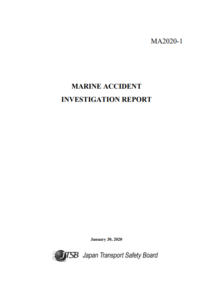Japan’s Transport Safety Board (JTSB) issued an investigation report on a collision incident between the general cargo ship SM3 and the oil tanker Koutoku Maru off Kanmon Port, in September 2018. Following investigation, JTSB noted that, when communicating with approaching vessels becomes necessary, masters and watch crew should not only call the vessel’s name but also implement VHF wireless telephone communication proactively.
The incident
On 29 September 2018, the SM3, with 10 crew members onboard, was proceeding north bound for Pohang Port, Republic of Korea, in Wakamatsu Passage of Kanmon Port.
Meanwhile, the oil tanker Koutoku Maru, with eight crew members onboard, was proceeding southeast bound for Setonaikai in No. 2 Kanmon Passage of Kanmon Port.
The two vessels collided at around 14:55, after having just entered Kanmon Passage.
SM3 suffered denting of its shell plate on its port fore side and port aft side.
Koutoku Maru lost its starboard anchor and suffered denting of its bulbous bow, etc.; however, there were no casualties or injuries on either vessel.
Probable causes
It is considered probable that the accident occurred because the master of SM3 intended to turn to the left and pass the bow of Koutoku Maru and boatswain of Koutoku Maru was maintaining the same course and ship speed, as a result of which both vessels collided.
It is considered probable that the master of SM3 intended SM3 to turn to the left and pass the bow of Koutoku Maru because of the possibility that he wanted to move ahead of a cargo ship proceeding northwest in Kanmon Passage and because he had the experience that other vessels kept out of the way of SM3 when he called their names by VHF wireless telephone, and that, at the time of the accident, the master of SM3 similarly thought that Koutoku Maru would turn to the right and avoid SM3 by passing off her stern.
It is considered probable that boatswain of Koutoku Maru was maintaining the same course and ship speed because, according to the navigation rules of Kanmon Port, SM3 was in a position whereby it had to keep out of the way of Koutoku Maru, and thus he was expecting SM3 to eventually avoid Koutoku Maru and diverted his attention to responding to a total three calls by VHF wireless telephone.
Recommendations
In view of the result of this accident investigation, JTSB recommends that the owner and the management company of SM3 shall provide thorough instruction to masters of its vessels to execute the following measures and shall also implement training in accordance with said measures:
- Masters and duty watch persons should utilize information provided by the Vessel Traffic Service Center, etc., effectively. In particular, they should give immediate attention to dangerous situations based on the content of warnings from the Center, etc., and respond appropriately.
- Masters and duty watch persons should navigate in accordance with rules that are established for the navigational area. In particular, when communicating with approaching vessels becomes necessary, they should not only call the vessel’s name but also implement VHF wireless telephone communication proactively and mutually confirm the maneuvering intentions.
- Masters should establish a system whereby the master is on the navigation bridge and personally handling ship maneuvering when navigating in narrow straits.
- Owners and operators of vessels should have masters of the vessels they own or operate unfailingly implement the above-mentioned items and be thorough in providing directions and training for them.
Explore more herebelow:

See also:

































































